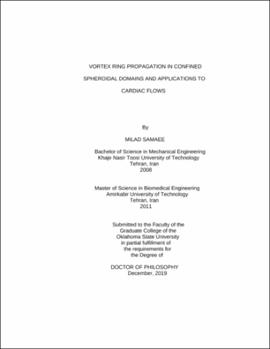| dc.contributor.advisor | Santhanakrishnan, Arvind | |
| dc.contributor.author | Samaee, Milad | |
| dc.date.accessioned | 2020-06-26T21:27:54Z | |
| dc.date.available | 2020-06-26T21:27:54Z | |
| dc.date.issued | 2019-12 | |
| dc.identifier.uri | https://hdl.handle.net/11244/324876 | |
| dc.description.abstract | Vortex ring formation is observed in the human cardiac left ventricle (LV) during diastole. Numerous studies to date have examined the intraventricular filling vortex for potential use in the diagnosis of cardiac dysfunction. However, a systematic understanding of the effects of LV size on vortex ring properties is currently unavailable. In diastolic dysfunction (LVDD), heart muscles can thicken and decrease the internal volume of the LV. On the other hand, by progressing diastolic dysfunction, the transmitral inflow changes and the impact of inflow altering on vortex ring properties is also unknown. In contrast to the considerable body of research on vortex ring propagation in semi-infinite domains and interaction with walls, only a limited number of studies have examined confined vortex ring dynamics. The latter studies only considered radially confined domains, which are a simplification to the combined radial and axial confinement observed in spheroidal domains such as the LV. We experimentally examined vortex ring propagation within three flexible-walled, semi-spheroidal physical models (semi-oblate, hemisphere, and semi-prolate) that presented both axial and radial confinement. 2D time-resolved particle image velocimetry (TR-PIV) measurements showed that while the formation process and peak circulation were nearly unaffected with changing geometry, increasing axial confinement increased the rate of normalized circulation decay. We next examined vortex propagation in an in-vitro model of the LV, under physiological hemodynamic. Two flexible-walled, anatomical physical models representative of a normal LV and an LV with asymmetric wall thickening characteristic of hypertrophic cardiomyopathy (HCM) were examined. We varied the end-diastolic volume (EDV) of the models to change the confinement level. Peak circulation was lowered in the HCM model and also in the normal LV model with lower EDV when compared to the normal LV model with normal EDV. In the end, we examined the role of transmitral inflow on vortex ring properties under different grades of diastolic dysfunction. The normal transmitral flow showed higher circulation strength, momentum flux, and stronger vortex ring compared to those of diastolic dysfunction. Our results suggest that peak circulation and normalized circulation decay rates have the potential link with LVDD from the fluid mechanics' point of view. | |
| dc.format | application/pdf | |
| dc.language | en_US | |
| dc.rights | Copyright is held by the author who has granted the Oklahoma State University Library the non-exclusive right to share this material in its institutional repository. Contact Digital Library Services at lib-dls@okstate.edu or 405-744-9161 for the permission policy on the use, reproduction or distribution of this material. | |
| dc.title | Vortex ring propagation in confined spheroidal domains and applications to cardiac flows | |
| dc.contributor.committeeMember | Jacob, Jamey | |
| dc.contributor.committeeMember | Sallam, Khaled | |
| dc.contributor.committeeMember | Madihally, Sundar | |
| dc.contributor.committeeMember | Feng, Yu | |
| osu.filename | Samaee_okstate_0664D_16593.pdf | |
| osu.accesstype | Open Access | |
| dc.type.genre | Dissertation | |
| dc.type.material | Text | |
| dc.subject.keywords | diastolic dysfunction | |
| dc.subject.keywords | formation time | |
| dc.subject.keywords | heart failure | |
| dc.subject.keywords | vortex ring | |
| thesis.degree.discipline | Mechanical and Aerospace Engineering | |
| thesis.degree.grantor | Oklahoma State University | |
